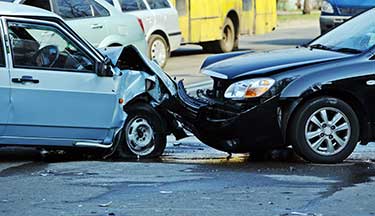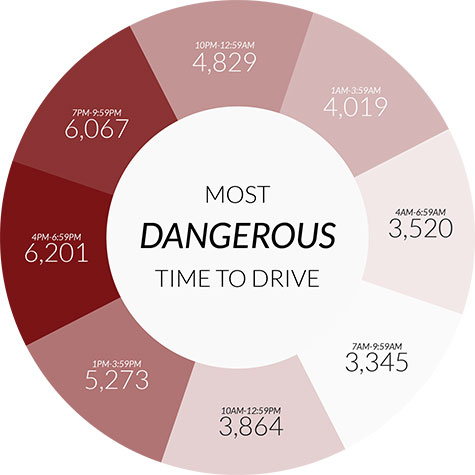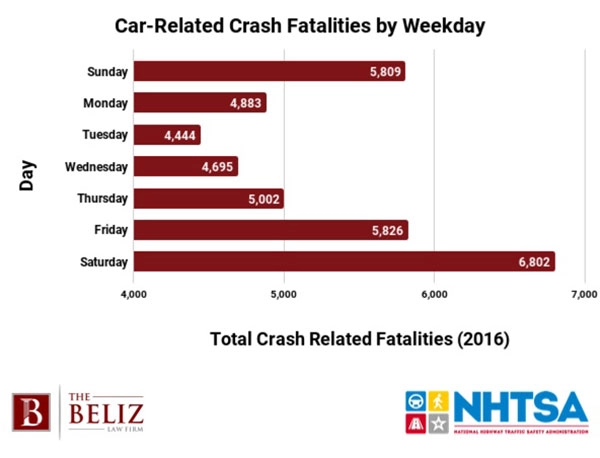
And statistics bear this assumption out. According to the National Highway Traffic Safety Administration (NHTSA), the most dangerous time to drive on the road is during afternoon rush hour traffic. Read on for more information about when your risk of getting into an accident is elevated.
A Closer Look at the Most Dangerous Time to Drive
Avvo looked at Fatality Analysis Reporting System data, provided by the federal government and broke down the number of fatalities according to the time of day in 3-hour increments:
- 1:00 am to 3:59 am: 4,019 fatalities
- 4:00 am to 6:59 am: 3,520 fatalities
- 7:00 am to 9:59 am: 3,345 fatalities
- 10:00 am to 12:59 pm: 3,864 fatalities
- 1:00 pm to 3:59 pm: 5,273 fatalities
- 4:00 pm to 6:59 pm: 6,201 fatalities
- 7:00 pm to 9:59 pm: 6,067 fatalities
- 10:00 pm to 12:59 am: 4,829 fatalities

One thing that jumps out is how safe the morning rush hour period is compared to driving home from work. For example, traffic fatalities early in the morning are very low. In fact, it seems that drivers are much more careful early in the morning. Indeed, fatalities are much lower in the 7:00 am to 9:59 am window than even in the 1:00 am to 3:59 am a window when fewer people should be on the road.
This could mean driving skills decrease as the day goes on. Being drained from work may increase the chance of a serious accident while driving home. Finally, darkness and visibility may increase fatal vehicle collisions.
The Most Dangerous Day to Drive
According to the Insurance Institute for Highway Safety (IIHS), the most dangerous day to drive is the Fourth of July, based on a 2016 analysis. This should not be entirely surprising.
As part of the festivities, many people enjoy far too much alcohol to drink, which impairs their driving ability. Also, because the weather on the Fourth is often hot, a driver will be even more impaired. With so many vehicles on the road, even sober drivers can become frustrated and engage in dangerous driving.
Based on the same 2016 analysis, the other most dangerous days to drive include:
- January 1
- September 18
- August 2
- August 27
- July 5
- October 2
Of the seven days of the week, Saturday is the most dangerous according to NHTSA. Actually, the weekend is when the most fatal accidents occur. Less traffic with higher speeds may be the reason for the higher numbers. Conversely, the safest day to be on the road is Tuesday.

In 2016, the number of car crash-related fatalities were as follows:
- Sunday: 5,809
- Monday: 4,883
- Tuesday: 4,444
- Wednesday: 4,695
- Thursday: 5,002
- Friday: 5,826
- Saturday: 6,802
If you need to go on a long trip, then Tuesday or Wednesday would seem to be ideal days.
Protecting Yourself
The reason so many accidents happen on certain days and at certain times is that roads are congested. But you probably need to be on the road at the same time, along with everyone else. What can you do?
Clearly, drivers should exercise extreme caution when driving during rush hour. Remember to leave enough room between you and other vehicles, preferably four seconds of time. Also be reasonable when someone is trying to merge into traffic.
If possible, you can scoot into the other lane, leaving the room.
You should also avoid drinking on holidays, since alcohol will dramatically slow down your reflexes and impair your judgment, thus increasing the likelihood of a crash. If you see someone driving erratically, report them to the authorities.
If you are feeling fatigued, remember to pull over to the side of the road.
Speak to a Long Beach Car Accident Lawyer
Rush hour might be the most dangerous time to drive, but motorists and pedestrians can suffer a serious injury at any time. If you have been injured in an accident, you need compensation to help you cover medical expenses, lost wages, and property damage. Your pain and suffering also warrant compensation.
Contact the Beliz Law Firm today. Our car accident lawyers can help you get the compensation you deserve and are prepared to negotiate aggressively on your behalf.
Call 562-452-3772 for a free consultation or send us an online contact form.
